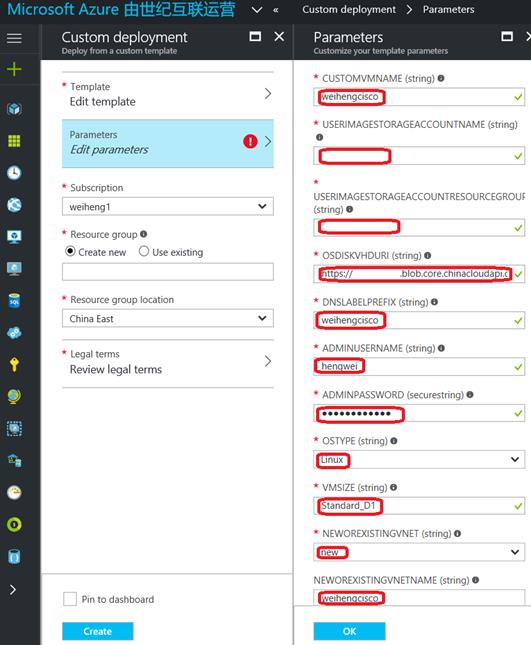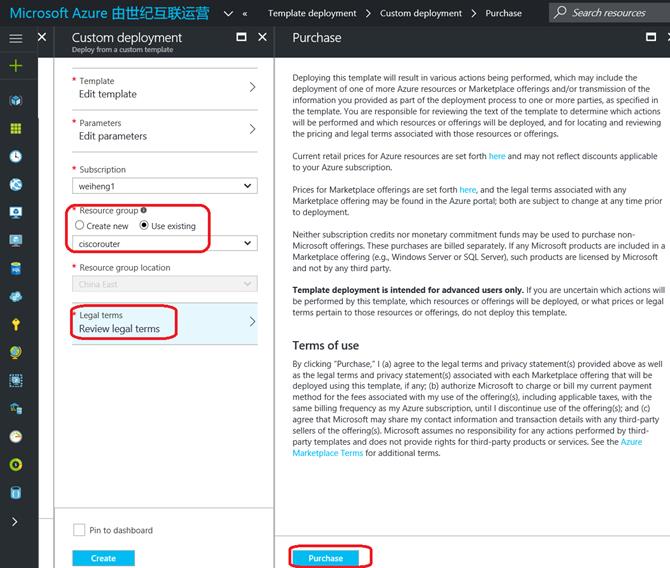用Json Template在Azure上创建Cisco CSR路由器
Posted hengzi
tags:
篇首语:本文由小常识网(cha138.com)小编为大家整理,主要介绍了用Json Template在Azure上创建Cisco CSR路由器相关的知识,希望对你有一定的参考价值。
Azure的ARM模式可以通过Json的模板创建VM。本文以Cisco的CSR的image为例,介绍如何用Json的创建VM。
一、Cisco CSR的Image
首先把Cisco CSR的image复制到一个存储账户中:
https://xxxx.blob.core.chinacloudapi.cn/image/CSR_3_16_4aS_CCO.vhd
创建VM的vhd文件也需要在这个存储账户中。
二、获得Json模板
在Github上找到From user image create VM的Json模板:
https://github.com/Azure/azure-quickstart-templates/tree/master/101-vm-from-user-image
把azuredeploy.json文件保存到本地:
为d:\\from_image.json文件。由于Global Azure的Disk目前已经prefer使用Management Disk了,Github上的template已经改成MD的template。
下面是采用普通存储账户的Json Template:
{ "$schema": "https://schema.management.azure.com/schemas/2015-01-01/deploymentTemplate.json#", "contentVersion": "1.0.0.0", "parameters": { "customVmName": { "type": "string", "metadata": { "description": "This is the name of the your VM" } }, "userImageStorageAccountName": { "type": "string", "metadata": { "description": "This is the name of the your storage account" } }, "userImageStorageAccountResourceGroupName": { "type": "string", "metadata": { "description": "Resource group of the existing storage account" } }, "osDiskVhdUri": { "type": "string", "metadata": { "description": "Uri of the your user image" } }, "dnsLabelPrefix": { "type": "string", "metadata": { "description": "DNS Label for the Public IP. Must be lowercase. It should match with the following regular expression: ^[a-z][a-z0-9-]{1,61}[a-z0-9]$ or it will raise an error." } }, "adminUserName": { "type": "string", "metadata": { "description": "User Name for the Virtual Machine" } }, "adminPassword": { "type": "securestring", "metadata": { "description": "Password for the Virtual Machine" } }, "osType": { "type": "string", "allowedValues": [ "Windows", "Linux" ], "metadata": { "description": "This is the OS that your VM will be running" } }, "vmSize": { "type": "string", "metadata": { "description": "This is the size of your VM" } }, "newOrExistingVnet": { "allowedValues": [ "new", "existing" ], "type": "string", "metadata": { "description": "Select if this template needs a new VNet or will reference an existing VNet" } }, "newOrExistingVnetName": { "type": "string", "defaultValue": "", "metadata": { "description": "New or Existing VNet Name" } }, "newOrExistingSubnetName": { "type": "string", "metadata": { "description": "New or Existing subnet Name" } }, "existingVnetResourceGroupName": { "type": "string", "metadata": { "description": "Resource group of the existing VNET" } } }, "variables": { "publicIPAddressName": "[concat(parameters(\'customVmName\'),\'IP\')]", "vmName": "[parameters(\'customVmName\')]", "nicName": "[concat(parameters(\'customVmName\'),\'Nic\')]", "publicIPAddressType": "Dynamic", "apiVersion": "2015-06-15", "templatelink": "[concat(\'https://raw.githubusercontent.com/singhkay/azure-quickstart-templates/master/101-vm-from-user-image/\',parameters(\'newOrExistingVnet\'),\'vnet.json\')]" }, "resources": [ { "apiVersion": "2015-01-01", "name": "vnet-template", "type": "Microsoft.Resources/deployments", "properties": { "mode": "incremental", "templateLink": { "uri": "[variables(\'templatelink\')]", "contentVersion": "1.0.0.0" }, "parameters": { "virtualNetworkName": { "value": "[parameters(\'newOrExistingVnetName\')]" }, "subnetName": { "value": "[parameters(\'newOrExistingSubnetName\')]" }, "existingVnetResourceGroupName": { "value": "[parameters(\'existingVnetResourceGroupName\')]" } } } }, { "apiVersion": "[variables(\'apiVersion\')]", "type": "Microsoft.Network/publicIPAddresses", "name": "[variables(\'publicIPAddressName\')]", "location": "[resourceGroup().location]", "properties": { "publicIPAllocationMethod": "[variables(\'publicIPAddressType\')]", "dnsSettings": { "domainNameLabel": "[parameters(\'dnsLabelPrefix\')]" } } }, { "apiVersion": "2016-03-30", "type": "Microsoft.Network/networkInterfaces", "name": "[variables(\'nicName\')]", "location": "[resourceGroup().location]", "dependsOn": [ "[concat(\'Microsoft.Network/publicIPAddresses/\', variables(\'publicIPAddressName\'))]", "Microsoft.Resources/deployments/vnet-template" ], "properties": { "ipConfigurations": [ { "name": "ipconfig1", "properties": { "privateIPAllocationMethod": "Dynamic", "publicIPAddress": { "id": "[resourceId(\'Microsoft.Network/publicIPAddresses\',variables(\'publicIPAddressName\'))]" }, "subnet": { "id": "[reference(\'vnet-template\').outputs.subnet1Ref.value]" } } } ] } }, { "apiVersion": "[variables(\'apiVersion\')]", "type": "Microsoft.Compute/virtualMachines", "name": "[variables(\'vmName\')]", "location": "[resourceGroup().location]", "dependsOn": [ "[concat(\'Microsoft.Network/networkInterfaces/\', variables(\'nicName\'))]" ], "properties": { "hardwareProfile": { "vmSize": "[parameters(\'vmSize\')]" }, "osProfile": { "computerName": "[variables(\'vmName\')]", "adminUsername": "[parameters(\'adminUsername\')]", "adminPassword": "[parameters(\'adminPassword\')]" }, "storageProfile": { "osDisk": { "name": "[concat(variables(\'vmName\'),\'-osDisk\')]", "osType": "[parameters(\'osType\')]", "caching": "ReadWrite", "createOption": "FromImage", "image": { "uri": "[parameters(\'osDiskVhdUri\')]" }, "vhd": { "uri": "[concat(reference(resourceId(parameters(\'userImageStorageAccountResourceGroupName\'), \'Microsoft.Storage/storageAccounts/\', parameters(\'userImageStorageAccountName\')), variables(\'apiVersion\')).primaryEndpoints.blob, \'vhds/\',variables(\'vmName\'), uniquestring(resourceGroup().id), \'osDisk.vhd\')]" } } }, "networkProfile": { "networkInterfaces": [ { "id": "[resourceId(\'Microsoft.Network/networkInterfaces\',variables(\'nicName\'))]" } ] }, "diagnosticsProfile": { "bootDiagnostics": { "enabled": "true", "storageUri": "[concat(reference(resourceId(parameters(\'userImageStorageAccountResourceGroupName\'), \'Microsoft.Storage/storageAccounts/\', parameters(\'userImageStorageAccountName\')), variables(\'apiVersion\')).primaryEndpoints.blob)]" } } } } ] }
三、通过模板创建Cisco CSR虚拟机
1. 登录Azure China的Portal
2. 在New中搜索template

如上图所示,点击Template Deployment。这里需要注意的是,目前必须是英文版本才可以使用这个功能。
3. 导入template

把刚刚的Json Template上传。
4. 填写相应的Parameters

根据实际值,填写相应的参数。需要注意的是Resource Group和Storage Account都要和image所在的Storage Account相同。
4. Legal Terms
把Legal Terms相应的内容填写完整:

然后点击create,创建VM。
四、登录创建的Cisco CSR router
Connecting to 42.159.203.233:22... Connection established. To escape to local shell, press Ctrl+Alt+]. hengweicisco#sh runn Building configuration... Current configuration : 1294 bytes ! ! Last configuration change at 10:21:56 UTC Mon Apr 24 2017 ! version 15.5 service timestamps debug datetime msec service timestamps log datetime msec no platform punt-keepalive disable-kernel-core platform console virtual ! hostname hengweicisco ! boot-start-marker boot-end-marker ! logging persistent size 1000000 filesize 8192 immediate ! aaa new-model ! aaa authentication login default local aaa authorization exec default local none ! aaa session-id common
......
以上是关于用Json Template在Azure上创建Cisco CSR路由器的主要内容,如果未能解决你的问题,请参考以下文章
在Azure上通过Powershell创建多Interface的Cisco CSR路由器
使用Json Template在Azure China创建ARM类型的虚拟机
来自 azure template.json 中流分析作业模板的服务总线的 sharedAccessPolicyKey